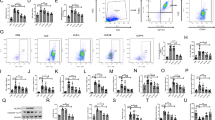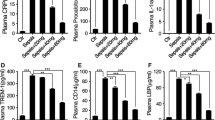Abstract
Myricetin belongs to the flavonoid family which is derived from plant source. It is well-known for the anti-inflammatory and anti-oxidative properties yet the clinical use of myricetin awaits further discovery. Acute lung injury (ALI) is commonly caused by sepsis which leads to enormous burden with high morbidity and mortality. In this study, a murine sepsis model was constructed by cecal ligation and puncture (CLP). The indicated dose of myricetin (100 mg/kg) was further administrated intragastrically. The survival rate test indicated that myricetin significantly improved the vitality of CLP-operated mice. The pathological changes in morphology, biomarkers of inflammatory response, oxidative stress response, and mitochondrial damage were further detected. Myricetin showed significant inhibitory effects on these changes in CLP-induced mice. Furthermore, expression levels of transcription factor Nrf2 and heme oxygenase-1 (HO-1) along with DNA binding activity of Nrf2 were analyzed by western blot and EMSA, indicating that myricetin positively regulates the Nrf2/HO-1 pathway in CLP-induced sepsis mice. Murine sepsis models with knockdown of Nrf2 and control were further established and suggested that myricetin might exert protective effects on sepsis lung injury in dependent with Nrf2. Our study provides novel mechanisms for the protective effect of myricetin in sepsis-associated acute lung injury.







Similar content being viewed by others
References
Ahmed SM, Luo L, Namani A, Wang XJ, Tang X (2017) Nrf2 signaling pathway: pivotal roles in inflammation. Biochim Biophys Acta Mol basis Dis 1863:585–597. https://doi.org/10.1016/j.bbadis.2016.11.005
Blanco J, Muriel-Bombín A, Sagredo V, Taboada F (2008) Incidence, organ dysfunction and mortality in severe sepsis: a Spanish multicentre study. Crit Care 12:R158
Bone RC, Balk RA, Cerra FB, Dellinger RP, Fein AM, Knaus WA, Schein RM, Sibbald WJ (1992) Definitions for sepsis and organ failure and guidelines for the use of innovative therapies in sepsis. The ACCP/SCCM Consensus Conference Committee American College of Chest Physicians/Society of Critical Care Medicine Chest 101:1644–1655
Buras JA, Holzmann B, Sitkovsky M (2005) Animal models of sepsis: setting the stage. Nat Rev Drug Discov 4:854–865
Chen Y et al (2017) Heat shock protein A12B protects vascular endothelial cells against sepsis-induced acute lung injury in mice cell. Physiol Biochem 42:156–168. https://doi.org/10.1159/000477308
Fan E (2005) Ventilatory management of acute lung injury and acute respiratory distress syndrome. JAMA 294:2889
Fan E, Brodie D, Slutsky AS (2018) Acute respiratory distress syndrome: advances in diagnosis and treatment. JAMA 319:698
Fang GS, Perkins GD, Gates S, Young D, Lamb SE (2011) Effect of intravenous beta-2 agonist treatment on clinical outcomes in acute respiratory distress syndrome (BALTI-2): a multicentre, randomised controlled trial. Lancet 379:229–235
Frandsen JR, Narayanasamy P (2018) Neuroprotection through flavonoid: enhancement of the glyoxalase pathway. Redox Biol 14:465–473. https://doi.org/10.1016/j.redox.2017.10.015
Frank JA, Wray CM, Mcauley DF, Schwendener R, Matthay MA (2006) Alveolar macrophages contribute to alveolar barrier dysfunction in ventilator-induced lung injury. Am J Phys Lung Cell Mol Phys 291:L1191–L1198
Han J-W et al (2019) Suppression of lung inflammation by the ethanol extract of Chung-Sang and the possible role of Nrf2. BMC Complement Altern Med 19:15. https://doi.org/10.1186/s12906-018-2422-3
Hong T (2013) Protective effect of myricetin in dextran sulphate sodium-induced murine ulcerative colitis. Mol Med Rep 7:565–570
Katzenstein ALA, Bloor CM, Leibow AA (1976) Diffuse alveolar damage-the role of oxygen, shock, and related factors. Am J Pathol 85:209–228
Keeley A, Hine P, Nsutebu E (2017) The recognition and management of sepsis and septic shock: a guide for non-intensivists. Postgrad Med J 93:626–634
Kim YK, Yeo M, Oh B, Kim H, Yang H, Cho SS, Gil M, Lee K (2017) Tussilagone inhibits the inflammatory response and improves survival in CLP-induced septic mice. Int J Mol Sci 18:E2744. https://doi.org/10.3390/ijms18122744
Kumar G, Kumar N, Taneja A, Kaleekal T, Nanchal R (2011) Nationwide trends of severe sepsis in the 21st century (2000-2007). Chest 140:1223–1231
Li JTMA, Su G et al (2015) Unexpected role for adaptive alphabetaTh17 cells in acute respiratory distress syndrome. J Immunol 195:87–95
Mantzarlis K, Tsolaki V, Zakynthinos E (2017) Role of oxidative stress and mitochondrial dysfunction in sepsis and potential therapies. Oxidative Med Cell Longev 2017:5985209. https://doi.org/10.1155/2017/5985209
Martin TR, Pistorese BP, Chi EY, Goodman RB, Matthay MA (1989) Effects of leukotriene B4 in the human lung. Recruitment of neutrophils into the alveolar spaces without a change in protein permeability. J Clin Invest 84:1609–1619
Matthay MA, Zemans RL, Zimmerman GA, Arabi YM, Beitler JR, Mercat A, Herridge M, Randolph AG, Calfee CS (2019) Acute respiratory distress syndrome. Nat Rev Dis Primers 5:18. https://doi.org/10.1038/s41572-019-0069-0
McAuley DFLJ, O’Kane CM et al (2014) Simvastatin in the acute respiratory distress syndrome. N Engl J Med 371:1695–1703
Perkins GD, Nathani N, McAuley DF, Gao F, Thickett DR (2007) In vitro and in vivo effects of salbutamol on neutrophil function in acute lung injury. Thorax 62:36–42
Pipeling MR, Fan E (2010) Therapies for refractory hypoxemia in acute respiratory distress syndrome. Jama 304:2521–2527
Poggi C, Dani C (2018) Sepsis and oxidative stress in the newborn: from pathogenesis to novel therapeutic targets. Oxidative Med Cell Longev 2018:9390140. https://doi.org/10.1155/2018/9390140
Rubenfeld GD, Herridge MS (n.d.) Epidemiology and outcomes of acute lung injury. Chest 131:554–562
Rungsung S et al (2018) Luteolin attenuates acute lung injury in experimental mouse model of sepsis. Cytokine 110:333–343. https://doi.org/10.1016/j.cyto.2018.03.042
Seymour CW, Liu VX, Iwashyna TJ, Brunkhorst FM, Angus DC (2016) Assessment of clinical criteria for sepsis for the Third International Consensus Definitions for Sepsis and Septic Shock (Sepsis-3). JAMA 315:762–774
Singer M et al (2016) The Third International Consensus Definitions for Sepsis and Septic Shock (Sepsis-3). Jama 315:775–787
Spadaro S, Park M, Turrini C, Tunstall T, Thwaites R, Mauri T, Ragazzi R, Ruggeri P, Hansel TT, Caramori G, Volta CA (2019) Biomarkers for acute respiratory distress syndrome and prospects for personalised medicine. J Inflamm (Lond) 16:1. https://doi.org/10.1186/s12950-018-0202-y
Sun Y et al (2018) Role of p-MKK7 in myricetin-induced protection against intestinal ischemia/reperfusion injury. Pharmacol Res 129:432–442
Sun J, Sun J, Zhou X (2019) Protective functions of myricetin in LPS-induced cardiomyocytes H9c2 cells injury by regulation of MALAT1. Eur J Med Res 24:20. https://doi.org/10.1186/s40001-019-0378-5
Thille AW, Esteban A, Fernández-Segoviano P, Rodriguez JM, Aramburu JA, Vargas-Errázuriz P, Martín-Pellicer A, Lorente JA, Frutos-Vivar F (2013) Chronology of histological lesions in acute respiratory distress syndrome with diffuse alveolar damage: a prospective cohort study of clinical autopsies. Lancet Respir Med 1:395–401
Tomashefski FJ (2000) Pulmonary pathology of acute respiratory distress syndrome. Clin Chest Med 21:435–466
Xu C et al (2019) Biogenic selenium nanoparticles synthesized by Lactobacillus casei ATCC 393 alleviate intestinal epithelial barrier dysfunction caused by oxidative stress via Nrf2 signaling-mediated mitochondrial pathway. Int J Nanomedicine 14:4491–4502. https://doi.org/10.2147/IJN.S199193
Yuan X, Liu Y, Hua X et al (2015) Myricetin ameliorates the symptoms of collagen-induced arthritis in mice by inhibiting cathepsin K activity. Immunopharmacol Immunotoxicol 37:513–519
Zhang N, Feng H, Liao HH, Chen S, Yang Z, Deng W, Tang QZ (2018) Myricetin attenuated LPS induced cardiac injury in vivo and in vitro. Phytother Res 32:459–470. https://doi.org/10.1002/ptr.5989
Author information
Authors and Affiliations
Contributions
XY conceived and designed research. HX and QQ conducted experiments and collected data. HX analyzed data. HX and XY wrote the manuscript. All authors read and approved the manuscript.
Besides, we state that all the data were generated in-house, and we did not use a paper mill.
Corresponding author
Ethics declarations
All experiments have been approved by the Institutional Ethics Animal Committee of Hebei Medical University with the official approval number (No. 2020-P009). All operations were conducted according to the guideline for the care and use of laboratory animals.
Conflict of interest
The authors declare that they have no conflicts of interest.
Additional information
Publisher’s note
Springer Nature remains neutral with regard to jurisdictional claims in published maps and institutional affiliations.
Electronic supplementary material
Supplementary Figure 1
(PNG 1861 kb)
Rights and permissions
About this article
Cite this article
Xu, H., Qi, Q. & Yan, X. Myricetin ameliorates sepsis-associated acute lung injury in a murine sepsis model. Naunyn-Schmiedeberg's Arch Pharmacol 394, 165–175 (2021). https://doi.org/10.1007/s00210-020-01880-8
Received:
Accepted:
Published:
Issue Date:
DOI: https://doi.org/10.1007/s00210-020-01880-8




